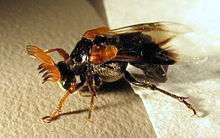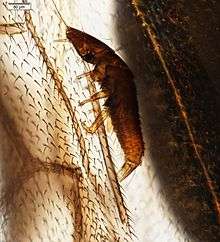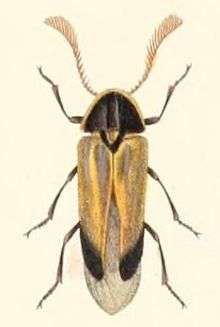Ripiphoridae
| Wedge-shaped beetles | |
|---|---|
 | |
| Note the characteristically small elytra and flabellate antennae | |
| Scientific classification | |
| Kingdom: | Animalia |
| Phylum: | Arthropoda |
| Class: | Insecta |
| Order: | Coleoptera |
| Suborder: | Polyphaga |
| Infraorder: | Cucujiformia |
| Superfamily: | Tenebrionoidea |
| Family: | Ripiphoridae Gemminger & Harold, 1870 |
| Subfamilies | |
| |


The Ripiphoridae (formerly spelled Rhipiphoridae) are a cosmopolitan family of some 450 described species of beetles. Informally they are known by the common name "wedge-shaped beetles". The Ripiphoridae are unusual among beetle families in that many species are hypermetamorphic parasitoids, an attribute that they share with the Meloidae. Members of the family differ in their choice of hosts, but most attack various species of bees or wasps, while some others attack cockroaches.
Many species of Ripiphoridae have abbreviated elytra, and flabellate or pectinate antennae. Genera include Allocinops, Rhipistena and Sharpides.[1]
Species that attack bees typically lay their eggs on flowers. There the eggs hatch almost immediately into small planidial larvae and lie in wait for a visiting host. The planidium mounts the bee and rides it back to the hive. There it dismounts and seeks a cell occupied by a host larva. The planidium then enters the body of the host. It changes its skin and shape, then remains more or less dormant until the host larva pupates. It then emerges from the bee pupa and begins to feed. It eats the entire pupa, then pupates in its turn and completes its metamorphosis before emerging from the hive to mate and lay eggs.[1][2]
Fossil species in the genera Paleoripiphorus and Macrosiagon have been described from mid- to lower-Cretaceous amber from sites in France, Germany and Burma.[3][4]
References
- 1 2 Falin, Z.H. (2002). "102. Ripiphoridae. Gemminger and Harold 1870 (1853)". In Arnett, R.H., jr.; Thomas, M.C.; Skelley, P.E.; Frank, J.H. American beetles. Volume 2. Polyphaga: Scarabaeoidea through Curculionoidea. Boca Raton, Florida: CRC Press LLC. pp. 431–444. doi:10.1201/9781420041231.ch6. ISBN 978-0-8493-0954-0.
- ↑ Lawrence, J.F.; Falin, Z.H.; Ślipiński, A. (2010). "Ripiphoridae Gemminger and Harold, 1870 (Gerstaecker, 1855)". In Leschen, R.A.B.; Beutel, R.G.; Lawrence, J.F. (volume eds.). Coleoptera, beetles. Volume 2: Morphology and systematics (Elateroidea, Bostrichiformia, Cucujiformia partim). New York: Walter de Gruyter. pp. 538–548. doi:10.1515/9783110911213.538. ISBN 3110190753.
- ↑ Perrichot V.; Nel A.; Neraudeau D. (2004). "Two new wedge-shaped beetles in Albo-Cenomanian ambers of France (Coleoptera: Ripiphoridae: Ripiphorinae)." (PDF). European Journal of Entomology. 101: 577–581. doi:10.14411/eje.2004.081.
- ↑ Batelka, J; François-Marie Collomb & André Nel (2006). "Macrosiagon deuvei n. sp. (Coleoptera: Ripiphoridae) from the French Eocene amber" (PDF). Ann. soc. entomol. Fr. 42 (1): 75–78. doi:10.1080/00379271.2006.10697451.
| Wikimedia Commons has media related to Ripiphoridae. |
| Wikispecies has information related to: Ripiphoridae |